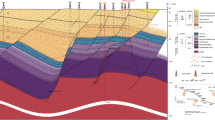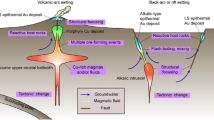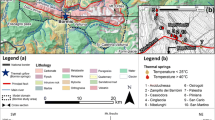Abstract
Grand Mesa is an erosional remnant on the southern margin of the Piceance basin (Colorado, USA) that appears to host topographically driven groundwater flow in low permeability strata via a pervasive network of vertical extensional fractures. The vertical fractures cut more than 1 km of clay-rich lithology ranging in age from Upper Cretaceous through Eocene, and likely formed from horizontal dilation, cooling, and erosional unloading associated with 2.8 km of regional uplift and 1.5 km of incision by the Gunnison and Colorado rivers. The vertical fractures create anisotropy in which vertical permeability exceeds horizontal permeability. This enhances vertical flow and depth of penetration of groundwater, favors local flow regimes over regional flow, and results in groundwater temperatures that are elevated by up to 10°C over mean surface temperatures at the location of springs. The uplift and cooling that formed the fractures may also have produced domains of abnormally underpressured pore fluids and natural gas within blocks of low permeability bedrock bounded by the fractures. Pore pressures inside these blocks may be in disequilibrium with the groundwater flow system due to ongoing stress release, and the long time scales required for pressure equilibration in the low permeability strata.
Résumé
Grand Mesa, situé dans les montagnes du Colorado (USA) est un vestige de l’érosion de la marge sud du basin de Piceance, dans lequel se rencontrent des écoulements souterrains gouvernés par le relief à travers des couches de faible perméabilité, empruntant un réseau développé de fractures verticales. Ces fractures ont recoupé plus de 1 km de formations lithologiques riches en argile, s’étendant du Crétacé supérieur à l’Eocène. Ces fractures résultent probablement de la dilatation horizontale, du refroidissement, et de la décompression due à l’érosion des terrains sus-jacents, associés à un soulèvement régional de 2.8 et à 1.5 km d’incision par les rivières de Gunnison et du Colorado. Les fractures verticales induisent une anisotropie (les perméabilités verticales étant très supérieures aux perméabilités horizontales) qui favorise les écoulements verticaux et la pénétration de l’eau souterraine en profondeur, suscite des régimes d’écoulement locaux au dépend de régimes régionaux et induisent des élévations de températures de l’eau souterraine jusqu’à 10°C par rapport à la température des sources. Le soulèvement et le refroidissement qui ont formé les fractures ont pu produire aussi des anomalies de pression interstitielle des fluides et des gaz à l’intérieur de blocks de faible perméabilité bordés de fractures. La pression de pore entre ces blocks peut être en déséquilibre avec le système d’écoulement de l’eau souterraine à cause de la décroissance continue des contraintes mécaniques, et des longues durées nécessaires à l’équilibre des pressions dans les couches de faible perméabilité.
Resumen
Grand Mesa es un remanente erosional en el margen sur de la cuenca del Piceance (Colorado, Estados Unidos) que aparentemente posee flujos de aguas subterráneas controlados por la topografía en estratos de permeabilidades bajas mediante una red dominada por extensas fracturas verticales. Las fracturas verticales cortan mas de 1 km de litología, principalmente arcillosa, que tiene edades que van desde el Cretácico superior hasta el Eoceno, y que probablemente fueron formadas por dilataciones horizontales, enfriamiento, y descargas erosivas asociadas con 2.8 km de empujes regionales y 1.5 km de incisiones por los ríos Gunnison y Colorado. Las fracturas verticales crearon anisotropía en la que la permeabilidad vertical es mayor que la permeabilidad horizontal. Esto favorece el flujo vertical y la profundidad de penetración del agua subterránea, favoreciendo regimenes de flujo locales sobre el flujo regional, y resultando en que la temperatura del agua en las vertientes sea hasta 10°C mayor que la temperatura promedio de la superficie. El empuje y enfriamiento que forma las fracturas, puede también haber producido dominios de subpresiones anormales en los fluidos existentes en los poros y en bolsas de gas natural en bloques de baja permeabilidad limitadas por las fracturas. La presión de poros en el interior de esos bloques, puede estar en desequilibrio con el flujo regional de aguas subterráneas, debido a la liberación de presiones y a la larga escala de tiempo necesaria para equilibrar presiones en los estratos de baja permeabilidad.
摘要
大台地是位于Piceance盆地 (美国科罗拉多州) 南缘的一处剥蚀残迹, 在其低渗透性地层中遍布的垂向延展的导水裂隙网络中存在由地形势驱动的地下水流。这些垂向裂隙切穿了从上白垩系到始新统的超过1km厚的富粘土岩层, 很可能是由与2.8km的区域性隆起和冈尼森河、科罗拉多河1.5km的下切相伴随的水平扩张、冷却和剥蚀卸载形成。垂向裂隙造成了各向异性, 导致垂向渗透率大于水平渗透率。这增加了地下水的垂向流动和穿透深度, 更利于局部的而非区域的地下水流动, 并导致泉水温度高出平均地表温度10°C。抬升和冷却不仅形成了裂隙, 也可在裂隙之间的低渗透性基岩断块中形成具有异常低压孔隙流体和天然气的区域。由于正在进行的应力释放及低渗地层中达到压力平衡需要较长的时间, 这些断块中的孔隙压力可能未与地下水流动系统平衡。
Resumo
O Grand Mesa é um remanescente da erosão na margem sul da bacia Piceance (Colorado, EUA) que aparenta apresentar escoamento subterrâneo conduzido topograficamente em estratos de baixa permeabilidade através de uma rede penetrante de fracturas extensionais verticais. As fracturas verticais cortam mais de 1 km de uma litologia rica em argila de idade do Cretácico Superior ao Eocénico, e provavelmente formadas a partir de dilatação horizontal, arrefecimento, e erosão associada com 2.8 km de levantamento regional (uplift) e 1.5 km de incisão pelos rios Gunnison e Colorado. As fracturas verticais criam anisotropia onde a permeabilidade vertical excede a permeabilidade horizontal. Isto aumenta o escoamento vertical e a profundidade de penetração de águas subterrâneas, favorece os regimes de escoamento local sobre o escoamento regional, e resulta em temperaturas de águas subterrâneas que se elevam até 10°C em relação às temperaturas superficiais médias nas nascentes. O uplift e o arrefecimento que formaram as fracturas podem também ter produzido domínios de subpressão anormais de fluidos intersticiais e de gás natural dentro dos blocos de rochas de baixa permeabilidade delimitados pelas fracturas. A pressão intersticial dentro destes blocos pode estar em desequilíbrio com o sistema de escoamento subterrâneo, devido à libertação em curso das tensões, e às longas escalas de tempo necessárias para o equilíbrio de pressões nos estratos de baixa permeabilidade.























Similar content being viewed by others
References
Anderson MP (2005) Heat as a ground water tracer. Ground Water 43(6):951–968
Brace WF (1980) Permeability of crystalline and argillaceous rocks. Int J Rock Mech Min Sci 17:241–245
Clauser C (1989) Conductive and convective heat flow components in the Rheingraben and implications for the deep permeability distribution. In: Beck AE, Garven G, Stegena L (eds) Hydrogeological regimes and their subsurface effects. Am Geophys Union Geophys Monogr 47(2):59–64
Comer JB, Park AJ, Tuncay K, Ortoleva PJ (2001) Predicting fractured gas reservoirs using a 3-D finite-element diagenetic, hydrologic, rock mechanics model, Rullison Field, Piceance basin, Colorado. AAPG annual meeting, Denver, CO, June 2001
Corbet TF, Bethke CM (1992) Disequilibrium fluid pressures and groundwater flow in the western Canada sedimentary basin. J Geophys Res 97(B5):7203–7217
Deming D (1993) Regional permeability estimates from investigations of coupled heat and groundwater flow, North Slope of Alaska. J Geophys Res 98:16271–16288
Deming D, Cranganu C, Lee Y (2002) Self-sealing in sedimentary basins. J Geophys Res 107(B12):2329. doi:10.1029/2001JB000504, 2002
Domenico PA, Palciauskas VV (1973) Theoretical analysis of forced convective heat transfer in regional groundwater flow. Geol Soc Am Bull 84:3803–3814
Ellis MS, Gaskill DL, Dunrud CR (1987) Geologic map of the Paonia and Gunnison area, Delta and Gunnison Counties, Colorado. Map C-109, US Geological Survey, Lakewood, CO
Engelder T (1982) Is there a generic relationship between selected regional joints and contemporary stress within the lithosphere of North America? Tecton 1:161–177
Forster C, Smith L (1989) The influence of groundwater flow on thermal regimes in mountainous terrain: a model study. J Geophys Res 97(B7):9439–9451
Grout MA (1990) Fracture history of the southern Piceance basin and tectonic development of intrabasin folds, northeastern Colorado plateau, Colorado. PhD Thesis, Colorado University, USA
Grout MA (1991) Cleats in coal beds of the southern Piceance basin, Colorado: correlation with regional and local fracture sets in associated clastic rocks. In: Schwochow SD, Murray DK, Fahy MF (eds) Coalbed methane of western North America. Rocky Mountain Assoc. of Geologists, Denver, CO, pp 35–47
Grout MA, Verbeek ER (1985) Fracture history of the Plateau Creek and adjacent Colorado River valleys, southern Piceance basin: implications for predicting joint patterns at depth. US Geol Surv Open-File Rep 85–744, 17 pp
Haxby WF, Turcotte DL (1976) Stress induced by the addition or removal of overburden and associated thermal effects. Geology 4:181–185
Jiao JJ, Zheng C (1998) Abnormal fluid pressures caused by deposition and erosion of sedimentary basins. J Hydrol 204:124–137
Lazear GD (2006) Evidence for deep groundwater flow and convective heat transport in mountainous terrain, Delta County, Colorado, USA. Hydrogeol J 14:1582–1598. doi:10.1007/s10040-006-0058-8
Long JCS, Witherspoon PA (1985) The relationship of the degree of interconnection to permeability in fracture networks. J Geophys Res 90(B4):3087–3098
Lorenz JC (1985) Tectonic and stress histories of the Piceance Creek basin and the MWX site, from 75 million years ago to the present. Report SAND84-2603, Sandia National Laboratories, Albuquerque, NM, 50 pp
Lorenz JC, Finley SJ (1991) Regional fractures: II, fracturing of Mesaverde reservoirs in the Piceance basin, Colorado. AAPG Bull 75:1738–1757
Lorenz JC, Finley SJ, Norman DI (1988) Tectonism, subsidence, and fracturing of Mesaverde reservoirs in the Piceance basin, Colorado. AAPG Bull 72(2):215
Manga M, Kirchner J (2004) Interpreting the temperature of water at cold springs and the importance of gravitational potential energy. Water Resour Res 40, W05110. doi:10.1029/2003WR002905
Manning CE, Ingebristen SE (1999) Permeability in the continental crust: implications of geothermal data and metamorphic systems. Rev Geophys 37:127–150
McPherson BJOL, Bredehoeft JD (2001) Overpressures in the Uinta basin, Utah: analysis using a three-dimensional basin evolution model. Water Resour Res 37:857–871
Muggeridge A, Abacioglu Y, England W, Smalley C (2005) The rate of pressure dissipation from abnormally pressured compartments. AAPG Bull 89:61–80
Neuzil CE (1995) Abnormal pressures as hydrodynamic phenomena. Am J Sci 295:742–786
Neuzil CE, Pollock DW (1983) Erosional unloading and fluid pressures in hydraulically ‘tight’ rocks. J Geol 91:179–193
Oshetski KC, Kucks RP (2000) Aeromagnetic map of Colorado. US Geol Surv Open-File Rep 00-0042. http://pubs.usgs.gov/of/2000//ofr 00-0042/Colorado.htm. Cited 5 May 2007
Pitman JK, Sprunt ES (1985) Origin and distribution of fractures in Tertiary and Cretaceous rocks, Piceance basin, Colorado, and their relation to hydrocarbon occurrence. AAPG Bull 69:5
Price NJ (1966) Fault and joint development in brittle and semi-brittle rock. Pergamon, New York, 176 pp
Secor DT Jr (1965) Role of fluid pressure in jointing. Am J Sci 263:633–646
Sibson RH (2003) Brittle-failure controls on maximum sustainable overpressure in different tectonic regimes. AAPG Bull 87:901–908
Smith L, Chapman DS (1983) On the thermal effects of groundwater flow. 1. Regional scale systems. J Geophys Res 88(B1):593–608
SMU Geothermal Lab Website (2004) Geothermal Map of the United States. http://www.SMU.edu/geothermal/. Cited 13 August 2005
Toth JA (1963) A theoretical analysis of groundwater flow in small drainage basins. J Geoph Res 68(16):4795–4811
Turcotte DL, Schubert G (2002) Geodynamics. Cambridge University Press, Cambridge
Verbeek ER, Grout MA (1984) Fracture studies in Cretaceous and Paleocene strata in and around the Piceance basin, Colorado: preliminary results and their bearing on a fracture-controlled natural gas reservoir at the MWX site. US Geol Surv Open-File Rep 84-156, 30 pp
Voight B, St. Pierre HPB (1974) Stress history and rock stress. In: Advances in rock mechanics. Proceedings of the Third Congress of the International Society for Rock Mechanics, Denver, CO, September 1974, pp 580–582
Willet SD, Chapman DS (1989) Temperatures, fluid flow and heat transfer mechanism in the Uinta basin. In: Beck AE, Garven G, Stegena L (eds) Hydrogeological regimes and their subsurface effects. Am Geophys Union Geophys Monogr 47(2):29–33
Williams CF, Narisimhan TN (1989) Hydrogeologic constraints on heat flow along the San Andreas fault: a testing of hypotheses. Earth Planet Sci Lett 92:131–143
Woodbury AP, Smith L (1988) Simultaneous inversion of hydrogeologic and thermal data. 2. Incorporation of thermal data. Water Resour Res 24:356–372
Xie X, Jiao JJ, Tang Z, Zheng C (2003) Evolution of abnormally low pressure and its implications for the hydrocarbon system in the southeast uplift zone of Songliao basin, China. AAPG Bull 87:99–119. doi:10.1306/080602870099
Acknowledgements
I wish to thank A. Trevena, W. Hood and C. I. Burch for valuable feedback on early drafts of this manuscript, and R Cole for helpful discussions regarding the evolution of the Piceance basin. Comments from reviewers were very helpful and lead to significant improvements in this report. Thanks also to F. P. Lazear for proof reading the manuscript, and for moral support throughout this project. This research was conducted purely out of scientific curiosity without financial support of any kind.
Author information
Authors and Affiliations
Corresponding author
Appendix: residual heat from an intrusion under Grand Mesa
Appendix: residual heat from an intrusion under Grand Mesa
Assume that the magnetic anomaly under Grand Mesa is associated with an intrusion of magma that is approximately cylindrical in shape with diameter of 3 km and height much greater than the diameter. Cooling is then assumed to be radial, and the spatial and temporal temperature distribution is governed by the differential equation
where κ is thermal diffusivity (m2/s) and r is radial distance. Using separation of variables
gives to two ordinary differential equations
where the prime denotes derivative with respect to r, and the dot denotes derivative with respect to time. Eq. (36) has the general solution
while Eq. (35) can be converted to the form of Bessel’s equation by change of variable s = λr giving
The general solution of Eq. (38) has the form
where J 0 and Y 0 are Bessel functions of order zero. Since Y 0 goes to infinity as r goes to zero, c 2 = 0. The temperature distribution then has the form
At t = 0, it is assumed that the intrusion is emplaced rapidly compared to the cooling time so that the intrusion has a uniform temperature T m that is in contact with country rock of uniform temperature T 0 at radius R from the center. Thus the boundary conditions at t = 0 are
where Δ = T m – T 0. This boundary condition is satisfied by superposition of a continuum of solutions of the form of Eq. (40) integrated over λ,
and the weighting function \(c_1 \left( \lambda \right) = R\mathop \Delta \limits_ \cdot J_1 \left( {\lambda R} \right)\) since the integral
satisfies Eq. (41). The general form for the temperature distribution as a function of time is then
Numerical integration of Eq. (44) produces the cooling curves shown in Fig. 4 of the main text.
Rights and permissions
About this article
Cite this article
Lazear, G.D. Fractures, convection and underpressure: hydrogeology on the southern margin of the Piceance basin, west-central Colorado, USA. Hydrogeol J 17, 641–664 (2009). https://doi.org/10.1007/s10040-008-0381-3
Received:
Accepted:
Published:
Issue Date:
DOI: https://doi.org/10.1007/s10040-008-0381-3




